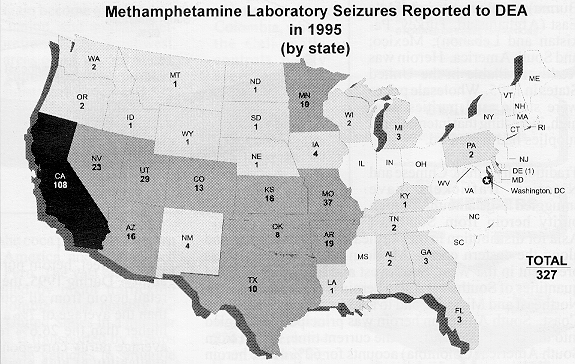| DEA Statement |
Response |
| Trafficking and abuse of methamphetamine in the United States have been on
the rise over the past few years, as indicated by investigative, seizure, price, purity,
and abuse data. As a result, this drug has had a devastating impact in an increasing
number of communities across the nation in 1995. Although more common in western areas of
the country, this impact was felt in areas not previously familiar with the harmful
effects of this powerful stimulant, such as the Midwest and Southeast. |
The DEA says that meth has had a devastating impact, but fails to provide
any real evidence to back up their assertion. For a better analysis of the
methamphetamine problem and its history, we recommend from the Consumers Union Report on Licit and Illicit
Drugs:
|
 |
| Almost all of the methamphetamine trafficked and abused in the United
States is produced in clandestine laboratories. Essential in manufacturing the drug is
ephedrine/ pseudoephedrine. The international law enforcement community has taken action
to prevent ephedrine diversion, and there are tight controls on ephedrine in the United
States. |
This ought to be good evidence that even if we could bomb South America
into oblivion, there would still be plenty of drug producers here in the United States to
fill the gap and rake in the profits. |
| Traditionally, the suppliers of methamphetamine in the United States have
been outlaw motorcycle gangs and independent traffickers. Although these groups are still
involved in the trade, Mexican drug trafficking organizations have come to dominate the
methamphetamine market in the United States. Their ascendancy in the methamphetamine trade
is due to their access to wholesale ephedrine sources of supply on the international
market, their ability to produce large quantities of high-purity methamphetamine on a
regular basis, and their well established cocaine, marijuana and heroin distribution
networks in the United States. |
Just like Al Capone in the 1920s. |
| According to the 1995 National Household Survey on Drug Abuse, the
estimated number of persons who have tried methamphetamine in their lifetime was 4.7
million, or 2.2 percent of the population in 1995. In 1994, the estimate had been 3.8
million. |
It should be noted that the relatively small number of people who have
used methamphetamine in their lifetime would not justify the existence of the DEA
in its present form, even if they were all currently using methamphetamine. |
| In the West, the statistics are alarming. The latest Drug Abuse Warning
Network figures indicate that methamphetamine related episodes tripled in Phoenix
between 1992 and 1994, and the number of deaths related to this drug increased five fold.
Los Angeles has had a 71 percent increase in emergency room visits due to methamphetamine
abuse, and a 222 percent increase in meth-related deaths. |
The DEA always talks in terms of the percentage increase in deaths, which
is always the largest when the actual number of deaths is the smallest. For example,
six deaths this year, as opposed to one death last year, is a five hundred percent
increase, but would still only represent a tiny fraction of the number killed by alcohol
and tobacco. And, as usual, they fail to include any hard statistics on either the
legal or illegal drugs. |


![]() DRCNet Response to the
DRCNet Response to the